Photo
album: "A few steps on the continent"
Fly
over a photo with the mouse to enlarge it
Click
on a photo to open it in a new window
In
November there is nearly no night left, only a little darker around midnight.
The emperor penguins have taken refuge on the scarce ice remained attached to
the continent. Some of them have even climbed upon the continent edge. The
chicks, now grown up, are gathered in the care of a few adults while their
parents come and go to fetch them food. The sea, fortunately, is now very close.
.At the beginning of December, the chicks are nearly as grown as the adults but
they still are not able to go into water because they have not lost their down.
The last days, while they are completing their moult, the adults are already
gone and the young stay without eating. Around mi-December, Thala Dan come back
with the personnel of the summer party and the new team for the next winter (the
eighteenth expedition in Adélie Land).
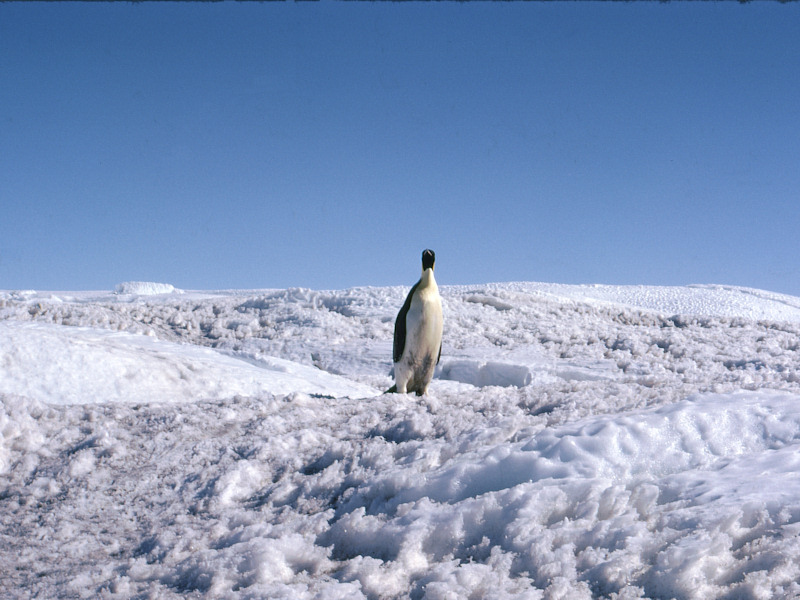 |
An emperor penguin is venturing
unto the continent ice cover. One day we found one fallen into a few-metre
deep crevasse. I climbed down with a comrade to pass him a cord under the
wings and we helped him to go up while other comrades were pulling the
cord from the surface. Once out of the crevasse and freed from the rope,
he walked away calmly as if I nothing happened to him. |
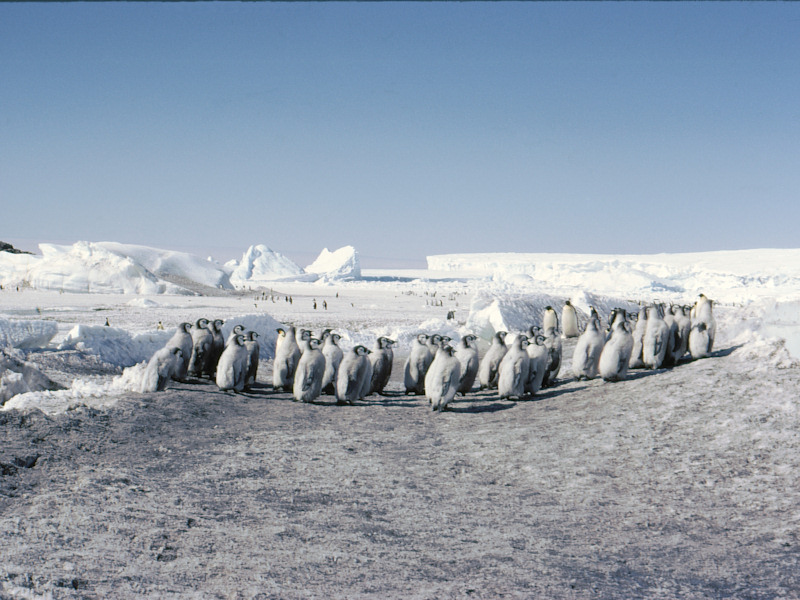 |
The chicks, already grown up, are
gathered in the care of a few adults, while the parents come and go to
fetch them food. How can they make out their own chick? The answer to this
question was fully understood only several years later. |
 |
The chicks are now fully grown up.
Many of them have already begun their moult. As long as they have not lost
all their down they will not be able to go into water to feed and to
follow the adults in open sea. |
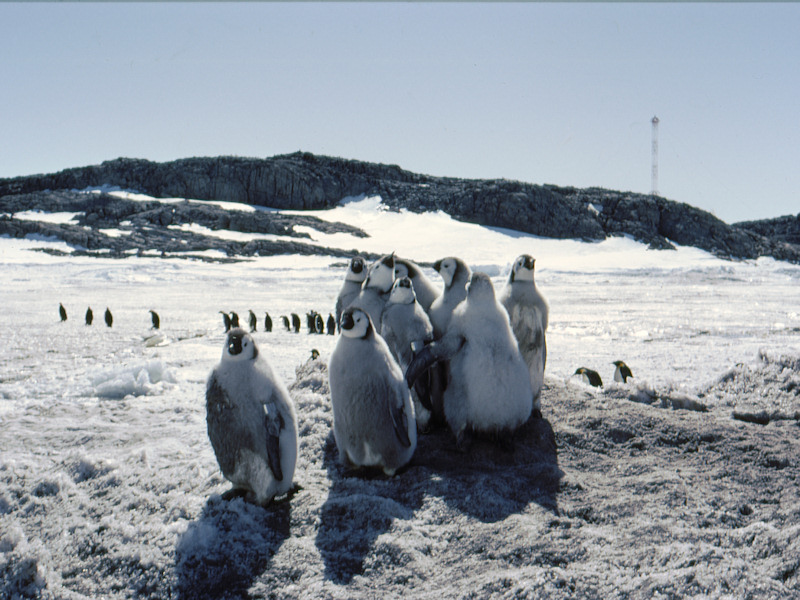 |
In the first half of December, the
adults will leave. The young penguins will have to wait the end of their
moult to leave in their turn. In the meantime, they will stay without
eating. |
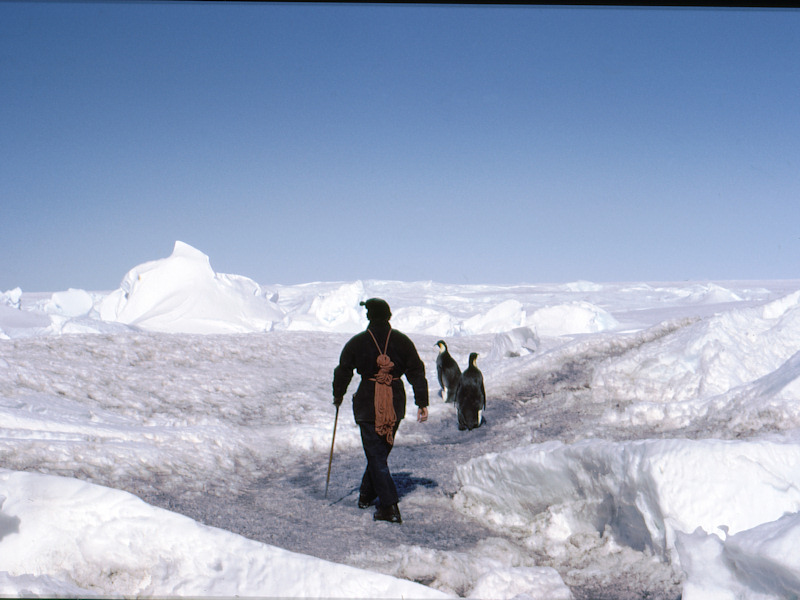 |
Let us follow these two emperor
penguins. Since it is no longer possible to take a walk on the sea, we
decided to take a few steps on the ice of the continent. This will be our
last walk because, soon, when the ship is arrived, we will be very busy,
and when she leaves, there will be no more ice left to allow us to walk
out of our island. |
 |
Near the coast there are a lot of
crevasses, sometimes hidden under the snow. Therefore we secured ourselves
to a rope. In the foreground, Jean Rousseau (Magne), behind, on the left
with a beard, Pierre Challon (our cook) and, on the right, André Santu
(Magne). |
 |
We are now on a very rough surface
where many crevasses can be seen. In the foreground, Jean-Pierre Jacquin (Racea),
then Jean (Magne) and Pierre (the cook). |
 |
We can see in the background, the
sea and a few icebergs. We stopped to take a little rest. In the
foreground, lying on the ice, Pierre, then from left to right, Jean, me
and André. |
 |
We are arrived to a very smooth and
slipping ice slope descending towards Cape Prud'homme ( we can
see a darker rock of this cape near the sea, on the left). As we are not equipped with
crampons, we will not go any farther. |
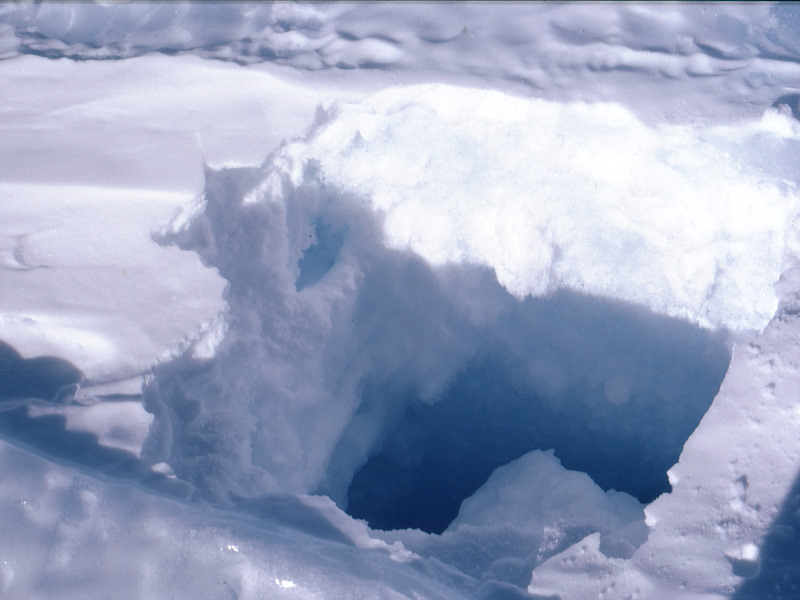 |
During our walk we have
seen several crevasses not always half hidden with snow like this one. We
must be very prudent and, before stepping on the snow, we must assure us
with the ice axe that the snow is compact enough to stand our weight. If
it is not the case, we have to seek and found a safer path.
|
 |
On the way back we made a stop on
Rostand island. Pierre is resting while André is looking at the rough sea
ice surface we just crossed. |
 |
The Danish ship Thala Dan left Le
Havre (France) at the beginning of October after having loaded the
materiel and most of the supplies destined for Dumont d'Urville base. She
stopped at Hobart in Tasmania, at the beginning of December, to embark the
personnel arrived by air, and to load the supplies bought in Australia.
She is now making her first rotation to the French base where she arrived
around mid-December. |
 |
After having assured the ice is
strong enough to be used as a pier to begin unloading the ship, the
technical people are preparing the vehicles they will use to tow the first
load. The weasels, American surplus of the second World War, have been
bought in great number by the French Polar Expeditions and have been used
many times in Greenland and in the Antarctic as well. |
 |
The first load is a fuel tank and
is by far, even if empty, the heaviest load to be moved over the ice. It
is equipped with two iron skis that were soldered to the ship's deck
during the journey from France. Not less than four weasels are needed to
make the tank move on. Fortunately, the specialists weren't wrong about
the strength of the ice and it didn't break under the weight of the tank. |
 |
After having been towed onto
Pétrels island, the tank will be installed near the other ones,
increasing thus the storing capability of fuel for the power generators.
The fuel used is a low temperature gas oil bought in Australia. |
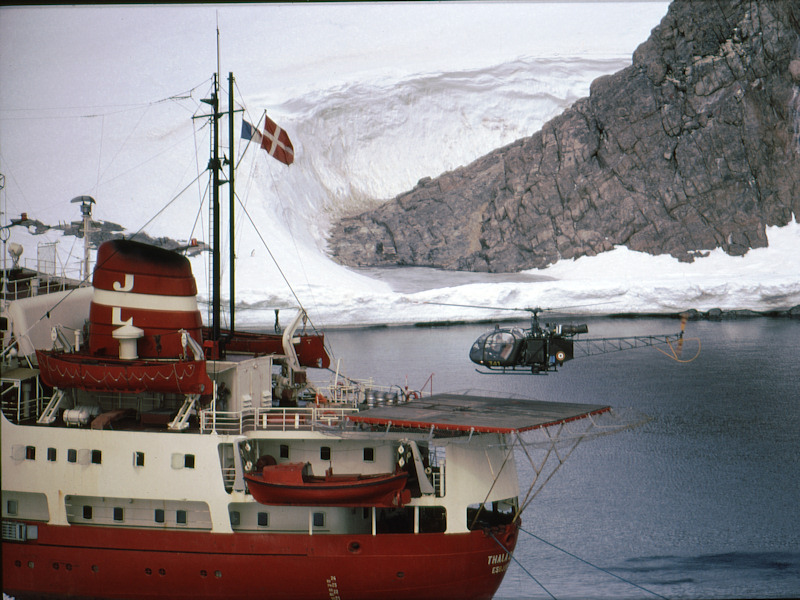 |
The French Air Forces' helicopter
Alouette 2 is taking off the Thala Dan's platform. The helicopter crew is
composed of two pilots and two mechanics from the French Air Forces. The
helicopter will stay on the base for the whole summer campaign. |
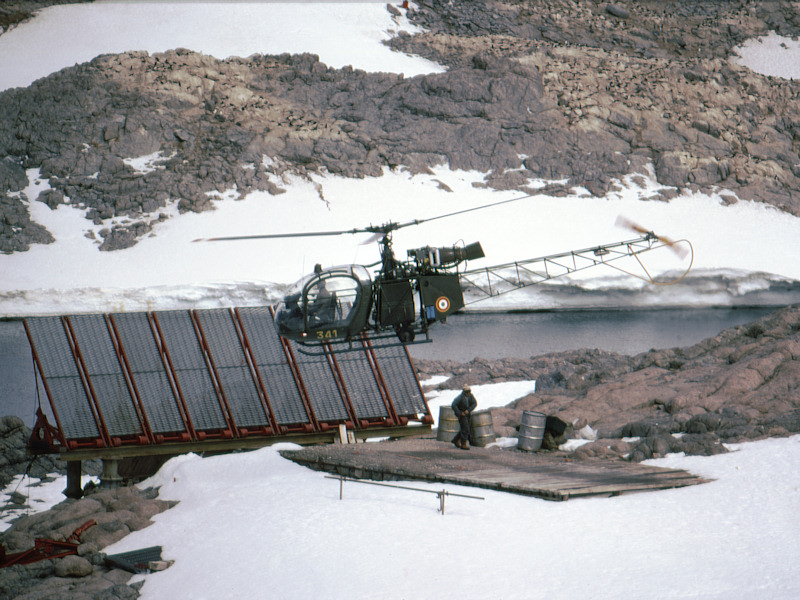 |
The Alouette 2 is landing on its
platform (DZ in the military language, meaning Drop Zone) on Pétrels
island. A grid protects the DZ from the more frequent winds. |
 |
The cases of supplies have been
transported near the shelters where the supplies will be stored. |
 |
Initially, all the cases are
distributed on the "pré" according to their final destination.
The complete unloading of the ship can last more than a week and all the
newly arrived people participate in the operation, while people ending
their sojourn keep on making the base and the scientific equipment working. |
 |
This view from helicopter gives an
idea of the area around the 73-metre antenna and of the difficulties we
could meet to reach it in winter during night with snow and a strong wind.
Cords installed along the path help us not to loose ourselves and to fight
against the wind. In case of heavy tempest, however, we didn't even try to
go, even if we had to replace the film or if the equipment had been out of
order, it wouldn't have been prudent. Fortunately we did not meet this
case very often. |
Go
back
.
.
.
.
.
.
.






